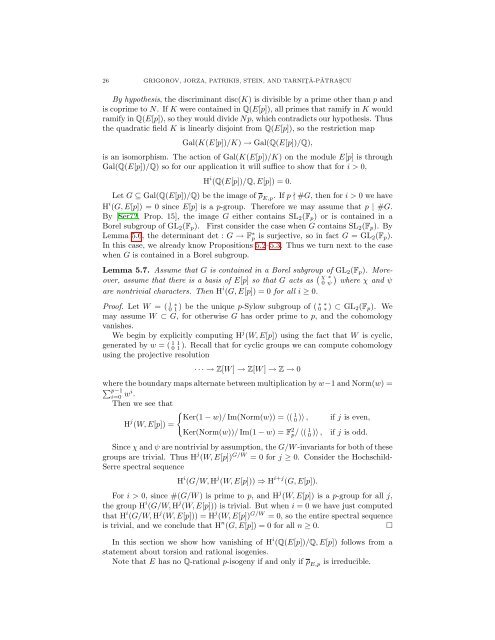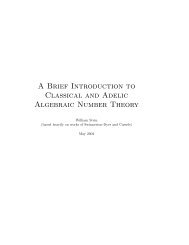COMPUTATIONAL VERIFICATION OF THE BIRCH ... - William Stein
COMPUTATIONAL VERIFICATION OF THE BIRCH ... - William Stein
COMPUTATIONAL VERIFICATION OF THE BIRCH ... - William Stein
Create successful ePaper yourself
Turn your PDF publications into a flip-book with our unique Google optimized e-Paper software.
26 GRIGOROV, JORZA, PATRIKIS, STEIN, AND TARNIT¸ Ǎ-PǍTRAS¸CU<br />
By hypothesis, the discriminant disc(K) is divisible by a prime other than p and<br />
is coprime to N. If K were contained in Q(E[p]), all primes that ramify in K would<br />
ramify in Q(E[p]), so they would divide Np, which contradicts our hypothesis. Thus<br />
the quadratic field K is linearly disjoint from Q(E[p]), so the restriction map<br />
Gal(K(E[p])/K) → Gal(Q(E[p])/Q),<br />
is an isomorphism. The action of Gal(K(E[p])/K) on the module E[p] is through<br />
Gal(Q(E[p])/Q) so for our application it will suffice to show that for i > 0,<br />
H i (Q(E[p])/Q, E[p]) = 0.<br />
Let G ⊆ Gal(Q(E[p])/Q) be the image of ρ E,p. If p ∤ #G, then for i > 0 we have<br />
H i (G, E[p]) = 0 since E[p] is a p-group. Therefore we may assume that p | #G.<br />
By [Ser72, Prop. 15], the image G either contains SL2(Fp) or is contained in a<br />
Borel subgroup of GL2(Fp). First consider the case when G contains SL2(Fp). By<br />
Lemma 5.6, the determinant det : G → F ∗ p is surjective, so in fact G = GL2(Fp).<br />
In this case, we already know Propositions 5.2–5.3. Thus we turn next to the case<br />
when G is contained in a Borel subgroup.<br />
Lemma 5.7. Assume that G is contained in a Borel subgroup of GL2(Fp). Moreover,<br />
assume that there is a basis of E[p] so that G acts as χ ∗ <br />
0 ψ where χ and ψ<br />
are nontrivial characters. Then H i (G, E[p]) = 0 for all i ≥ 0.<br />
Proof. Let W = (<br />
1 ∗<br />
∗ ∗<br />
0 1 ) be the unique p-Sylow subgroup of ( 0 ∗ ) ⊂ GL2(Fp). We<br />
may assume W ⊂ G, for otherwise G has order prime to p, and the cohomology<br />
vanishes.<br />
We begin by explicitly computing H j (W, E[p]) using the fact that W is cyclic,<br />
generated by w = ( 1 1<br />
0 1 ). Recall that for cyclic groups we can compute cohomology<br />
using the projective resolution<br />
· · · → Z[W ] → Z[W ] → Z → 0<br />
where the boundary maps alternate between multiplication by w−1 and Norm(w) =<br />
p−1 i=0 wi .<br />
Then we see that<br />
<br />
Ker(1 − w)/ Im(Norm(w)) = 〈( 1<br />
0 )〉 , if j is even,<br />
H j (W, E[p]) =<br />
Ker(Norm(w))/ Im(1 − w) = F2 p/ 〈( 1 0 )〉 , if j is odd.<br />
Since χ and ψ are nontrivial by assumption, the G/W -invariants for both of these<br />
groups are trivial. Thus H j (W, E[p]) G/W = 0 for j ≥ 0. Consider the Hochschild-<br />
Serre spectral sequence<br />
H i (G/W, H j (W, E[p])) ⇒ H i+j (G, E[p]).<br />
For i > 0, since #(G/W ) is prime to p, and H j (W, E[p]) is a p-group for all j,<br />
the group H i (G/W, H j (W, E[p])) is trivial. But when i = 0 we have just computed<br />
that H i (G/W, H j (W, E[p])) = H j (W, E[p]) G/W = 0, so the entire spectral sequence<br />
is trivial, and we conclude that H n (G, E[p]) = 0 for all n ≥ 0. <br />
In this section we show how vanishing of H i (Q(E[p])/Q, E[p]) follows from a<br />
statement about torsion and rational isogenies.<br />
Note that E has no Q-rational p-isogeny if and only if ρ E,p is irreducible.
















